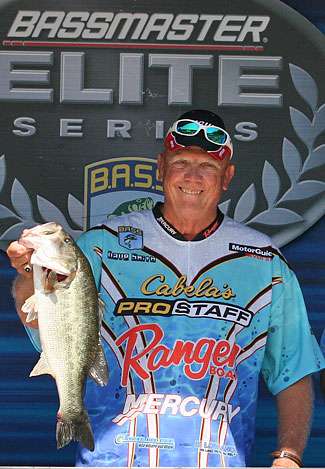
David Smith — Day 1
(7 pounds, 1 ounce)
David Smith caught his 7-pound, 1-ounce bass on Day 1 after spotting her on a bed during practice.
"I saw her during practice and knew she was on the bed. She was in a shallow pocket — less than 5 feet deep — alongside a weedline. I went back on the first day of the tournament but couldn't see her because of the wind. So, I started casting blind around the area with a drop shot rig. I figured she'd take that quick enough if I put it in front of her.
"That might not be the most efficient way to fish for a bedding female, but when you're fishing a tournament you have to have a couple of big bites each day or you're not going to get a check. Sometimes you do things the best way you can."
His drop shot rig consisted of a Roboworm Straight Tail Finesse worm — purple with red flake — and a 3/16-ounce Cabela's drop shot weight. He fished with a 6 1/2-foot, medium-heavy Cabela's rod and a Shimano Calais DC high speed reel. His line choice was 8-pound-test Gamma fluorocarbon line.
"I think details are important in this business," said Smith. "The Gamma line is clear, flexible and strong. You need that when fishing for big fish in clear, shallow water. And the rod from Cabela's is as good as anything on the market.
"But the really important thing about my rig was the reel. A high speed reel lets you fish faster when you need to but if you want to slow down all you have to do is stop cranking so fast. I was able to make repeated casts with it, shake my rig around and then get everything back fast so I could cast again. That's the only way you can blind cast to a bedding female, which is what I had to do.
"And, don't let anyone tell you a high speed reel isn't strong enough or tough enough to handle big bass. That's nonsense. The Shimano Calais DC with all the computer controls on it is more than adequate for the job. I don't care how big the bass is."
Kenyon Hill — Day 4
(7 pounds, 1 ounce)
"It's one of those things," said Hill. "I found the point the day before (Saturday) and was catching a lot of bigger bass on it. I finally left with the fish still biting because I wanted to save it for the final day. I told the fellow in the boat with me that this was the kind of place a guy could win on if he fished it right."
The kind of place of which Hill speaks is a gently sloping, gravel based point that's very shallow on top and runs way out into the lake. "It really wasn't much different than anywhere else I was fishing — gravel and small rock, shallow on top, gently sloping sides and very long — but for some reason it held big bass."
Fishing it right means going back every so often during the day to see if they're biting. And, when they are biting, only taking what you need for the day. Save the rest for another day.
"I was careful on Saturday not to wear it out, but when Sunday came I fished it hard. I was catching the daylights out of them on the Carolina rig, so I thought I'd try a Tennessee shad Sebile swimbait Peter T gave me and see if I couldn't catch a good one.
"I threw it out and reeled it back real slow. The fish were roaming around on the point but there was no cover on it. They didn't have anywhere to hide. That made them real spooky. Too much noise or too fast a retrieve and they would shy away rather than bite.
"Well, I did that and caught a 5-pounder. I immediately culled and then made another cast with the same swimbait near the same spot. That's when I caught the 7-pound, 1-ounce big bass.
"Sometimes it's a matter of following your instincts. You're fishing a tournament. You've got to pace yourself and your spots but you've also got to catch a couple of big fish if you expect to win. I found the right spot and was experienced enough not to over fish it when I did."
Hill used a medium action, 7 1/2-foot American Rodsmith Mag Strike rod with a 6.3:1 ratio Abu Garcia Revo reel and 17-pound-test Berkley Trilene 100% Fluorocarbon.




